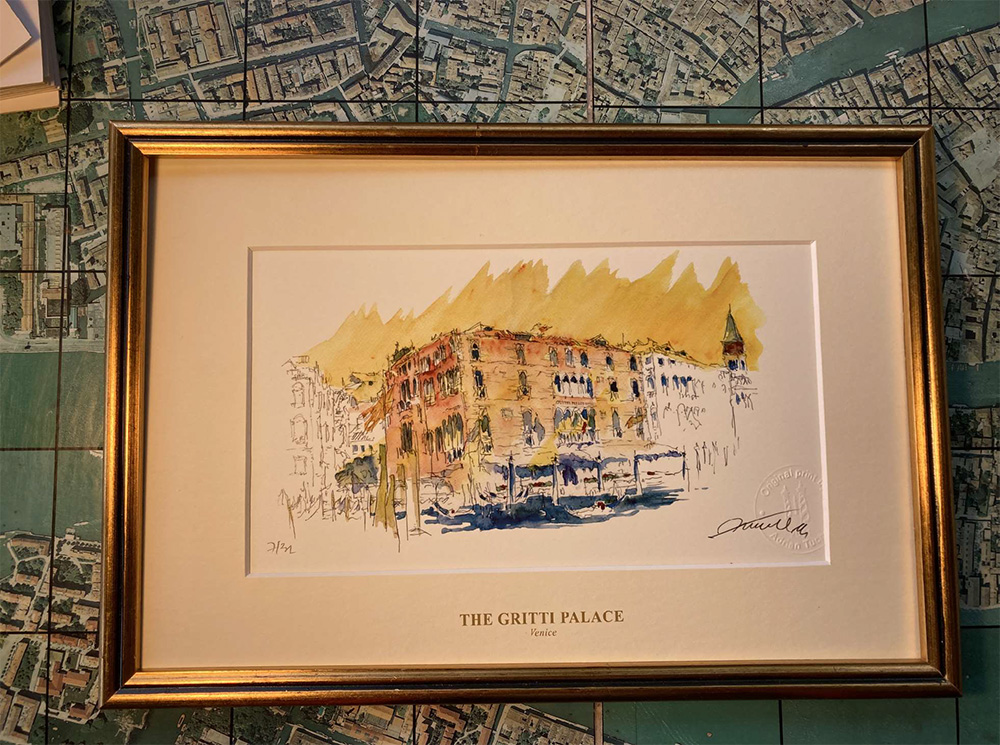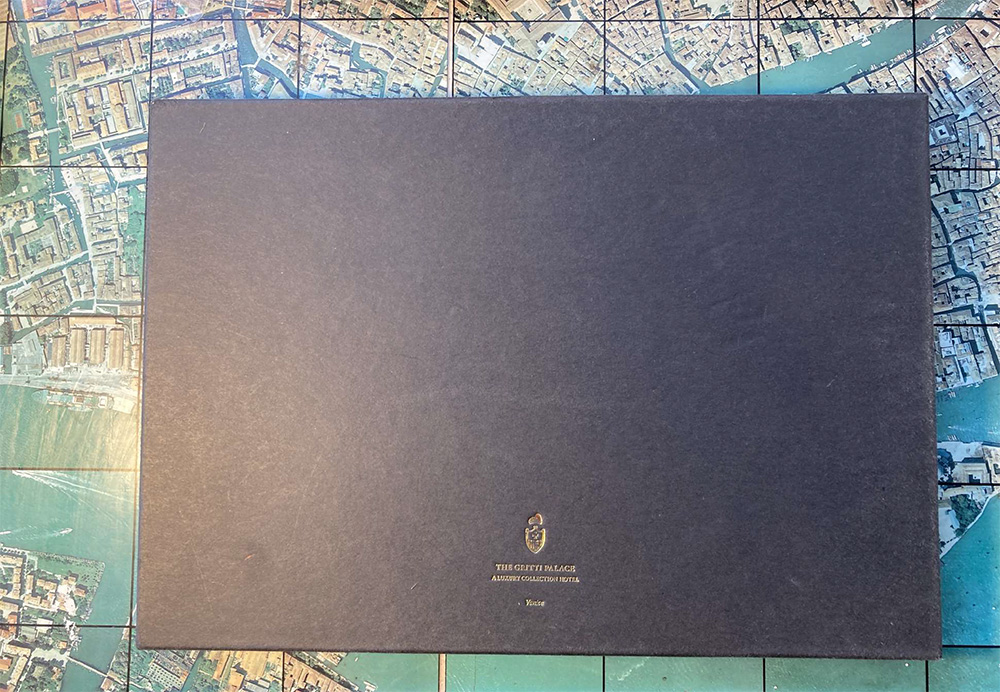Guests were thrilled to receive a thoughtful gift—a painting beautifully capturing the view from their room. The guests reaction to receiving the gift led the client to promptly order additional prints.


This artistic collaboration continued with the use of these views to decorate menus, invitations for events, conferences, weddings & celebrations.
A large greeting card of the hotel with their logo was used for a variety of events. As a smaller gift idea, we produced a set of bookmarks of the hotel chain including the Gritti.
For Christmas we made a personalised card complete with Christmas tree and gifts.

This project concluded in an exhibition at Palazzo Franchetti from 6th September to 28th September 2014, exhibiting and showing the artistic portrait of The Gritti alongside the views of Piazza San Marco personalised together with details of the Sestiere of Dorsoduro.
We are still offering and supplying our gift boxes to the Gritti.
The restoration
Restoring any historic property in Venice is not for the faint of heart, however, when the property is a 15th century Palazzo that was once a private residence for Andrea Gritti (a grain merchant turned Dodge) and then a hotel (from 1895), the task to restore its past was daunting. The restoration of The Gritti Palace to its original grandeur (achieved in 15 month) was finished in May 2013 at a cost of 50 million dollars. The process included the incorporation of modern hydraulic engineering to protect the building during high tides, and the addition of environmentally-friendly measures such as the use of LED lighting throughout the hotel’s public areas and guest rooms. When the Luxury Collection Hotels & Resorts (part of Starwood Hotels & Resorts) announced their plans to renovate and restore the hotel, it was understood that something special will happen. It went beyond preventing frequent flooding on the ground floor (annoying for both guests and staff), but also doing pain-staking restorations of antique artwork, furniture and even sourcing rare reproductions of Rubelli Venetian archival fabrics.
Each suite has a story, from the Peggy Guggenheim 50’s-style suite (honouring the legendary art collector who requented the hotel) to the Ernest Hemingway Palazzo Presidential Suite. Hemingway famously wrote about The Gritti Palace in his novel Across the River and Into the Trees, and like a few other literary legacies, he once considered the hotel his home.
One of the most sought after suites (and the most unique) includes the Redentore Terrazza. It comes with its own circular staircase, rooftop terrace, and even a plunge pool. The two-story suite is a new addition to the hotel and sits on the top floor of the palazzo overlooking the Grand Canal and the famous Basilica. It includes also a private elevator that takes you directly from the lobby to the suite. Built in 1475 along the Grand Canal, a stone’s throw from Piazza San Marco, Venice’s GRITTI PALACE has been a hallowed haven for centuries. It functioned first as a home for the aristocratic Pisani and Gritti families, the latter acquiring it in 1522.
Since 1948 it has served as a luxury hotel, offering sumptuous shelter to notable travellers from teh whoel world over. Richard Burton and Elizabeth Taylor enjoyed staying at The Gritti in their heyday, as did Ernest Hemingway and even Winston Churchill, who stayed during the 1948 Venice Film Festival. By the time Sheraton — which was acquired by Starwood in 1998 — purchased the Gritti from the Aga Kahn in the mid-1990s, it was more than just an iconic destination: It had become a precious — and perishable — archive of antiques and art, all in dire need of preserving, and not just for nostalgia’s sake but to ensure the future of this extraordinary collection.
The Gritti
Although there is no official evidence of the actual date of construction of the Palazzo, its origin can be established towards the end of the 14th century. The façade itself reveals that it was altered and restored many times. According to some sources, the façade was once decorated with frescos attributed to Giorgione. In the year 1525 the doge Andrea Gritti moved in, Andrea Gritti (1455 – December 1538) was the Doge of Venice from 1523 to 1538.
Gritti spent much of his early life in Constantinople as a grain merchant, looking after Venetian interests. In the late 1490s he was using his commercial correspondence to send encoded information to Venice regarding the movements of the Turkish navy. In 1499, he was imprisoned on charges of espionage, but escaped execution due to his friendship with the Vizier, and was released several years later.